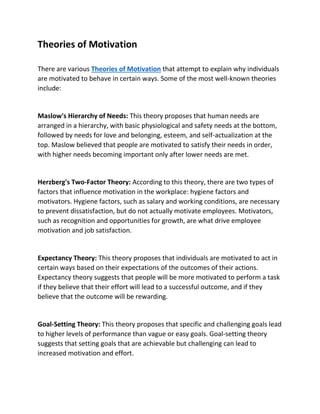Theories of Motivation.docx
•Download as DOCX, PDF•
0 likes•2 views
Understanding complexity: The world is complicated, and theories help us simplify and comprehend it. They give a framework for organising and structuring knowledge, helping us to detect patterns, relationships, and links between various aspects. Theories help us comprehend complicated systems and phenomena better.
Report
Share
Report
Share

Recommended
Recommended
More Related Content
Similar to Theories of Motivation.docx
Similar to Theories of Motivation.docx (20)
7.1 The Importance of Worker Motivation What motivates people .docx

7.1 The Importance of Worker Motivation What motivates people .docx
More from RoshniChauhan24
More from RoshniChauhan24 (6)
Recently uploaded
God is a creative God Gen 1:1. All that He created was “good”, could also be translated “beautiful”. God created man in His own image Gen 1:27. Maths helps us discover the beauty that God has created in His world and, in turn, create beautiful designs to serve and enrich the lives of others.
Explore beautiful and ugly buildings. Mathematics helps us create beautiful d...

Explore beautiful and ugly buildings. Mathematics helps us create beautiful d...christianmathematics
Recently uploaded (20)
Beyond the EU: DORA and NIS 2 Directive's Global Impact

Beyond the EU: DORA and NIS 2 Directive's Global Impact
Basic Civil Engineering first year Notes- Chapter 4 Building.pptx

Basic Civil Engineering first year Notes- Chapter 4 Building.pptx
Mixin Classes in Odoo 17 How to Extend Models Using Mixin Classes

Mixin Classes in Odoo 17 How to Extend Models Using Mixin Classes
Presentation by Andreas Schleicher Tackling the School Absenteeism Crisis 30 ...

Presentation by Andreas Schleicher Tackling the School Absenteeism Crisis 30 ...
SECOND SEMESTER TOPIC COVERAGE SY 2023-2024 Trends, Networks, and Critical Th...

SECOND SEMESTER TOPIC COVERAGE SY 2023-2024 Trends, Networks, and Critical Th...
Ecological Succession. ( ECOSYSTEM, B. Pharmacy, 1st Year, Sem-II, Environmen...

Ecological Succession. ( ECOSYSTEM, B. Pharmacy, 1st Year, Sem-II, Environmen...
Explore beautiful and ugly buildings. Mathematics helps us create beautiful d...

Explore beautiful and ugly buildings. Mathematics helps us create beautiful d...
Measures of Central Tendency: Mean, Median and Mode

Measures of Central Tendency: Mean, Median and Mode
ICT Role in 21st Century Education & its Challenges.pptx

ICT Role in 21st Century Education & its Challenges.pptx
Z Score,T Score, Percential Rank and Box Plot Graph

Z Score,T Score, Percential Rank and Box Plot Graph
Theories of Motivation.docx
- 1. Theories of Motivation There are various Theories of Motivation that attempt to explain why individuals are motivated to behave in certain ways. Some of the most well-known theories include: Maslow's Hierarchy of Needs: This theory proposes that human needs are arranged in a hierarchy, with basic physiological and safety needs at the bottom, followed by needs for love and belonging, esteem, and self-actualization at the top. Maslow believed that people are motivated to satisfy their needs in order, with higher needs becoming important only after lower needs are met. Herzberg's Two-Factor Theory: According to this theory, there are two types of factors that influence motivation in the workplace: hygiene factors and motivators. Hygiene factors, such as salary and working conditions, are necessary to prevent dissatisfaction, but do not actually motivate employees. Motivators, such as recognition and opportunities for growth, are what drive employee motivation and job satisfaction. Expectancy Theory: This theory proposes that individuals are motivated to act in certain ways based on their expectations of the outcomes of their actions. Expectancy theory suggests that people will be more motivated to perform a task if they believe that their effort will lead to a successful outcome, and if they believe that the outcome will be rewarding. Goal-Setting Theory: This theory proposes that specific and challenging goals lead to higher levels of performance than vague or easy goals. Goal-setting theory suggests that setting goals that are achievable but challenging can lead to increased motivation and effort.
- 2. Self-Determination Theory: According to this theory, individuals are motivated to behave in certain ways when they have autonomy, competence, and relatedness. Autonomy refers to the ability to make decisions about one's own behavior, competence refers to the sense of mastery or skill in a particular area, and relatedness refers to the sense of connection to others. Equity Theory: This theory proposes that individuals are motivated when they perceive that they are being treated fairly in comparison to others. Equity theory suggests that people will be motivated to work harder if they believe that they are being compensated fairly for their work in comparison to others.